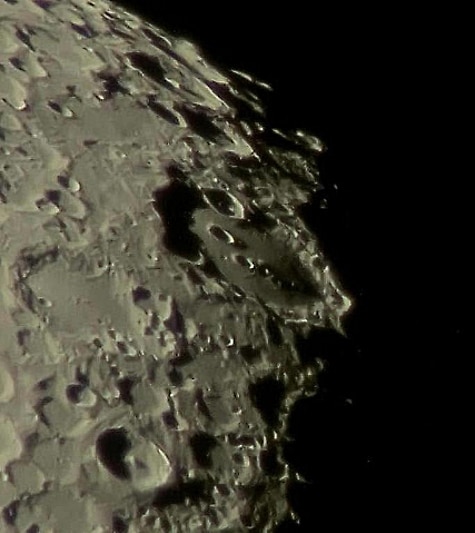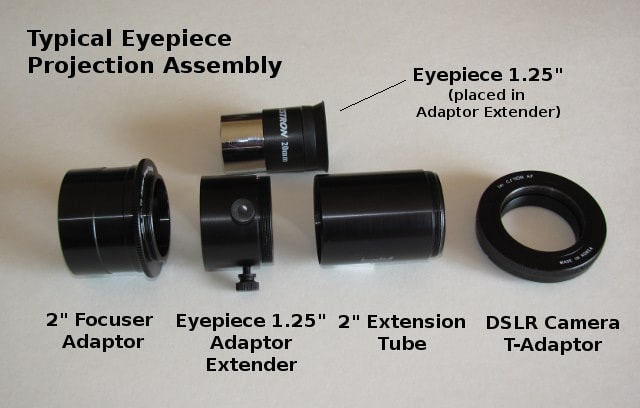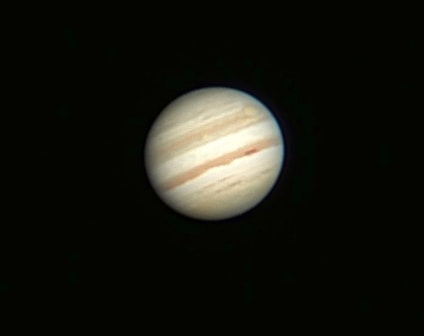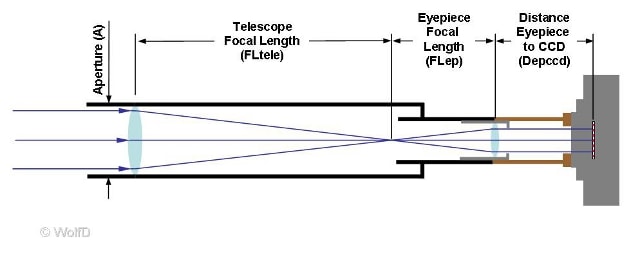
Greater magnification and increased focal length come however at a price. Higher focal length (at the same aperture) results in a higher focal ratio number (1/f). The higher the focal ratio number the fainter the image becomes. This demands longer exposure times or higher ISO speeds to achieve a decent image brightness. Furthermore, constantly moving air layers diffract incoming light. That means, with stronger magnification distortion is magnified as well. The same is true for any mount and telescope shake or vibration.

How to do it?
The following paragraphs describe equipment that is needed and such which is additionally recommended to make photographer’s life easier. I will share some experiences that I had to learn the hard way; it will help you getting good results sooner.
Mount
- The mount needs to be strong and sturdy. It has to carry all the weight of telescope, camera and all accessories, furthermore it has to stand steady, even with light breezes.
- Many manufacturers are quite “generous” when listing weight capabilities of mounts and tripods in their data sheets. Unfortunately, this leads often to unsatisfactory imaging experiences.
- Never max out a mount load. The old astrophotographers’ rule still applies: actual equipment weight should not exceed half of the mounts specified load capability.
- Many astrophotographers do not extend the tripod legs for better stability and minimal vibration.
- Balance the mount very carefully with camera and all accessories attached.
- Polar align German Equatorial Mounts (GEM) with great care. It helps “keeping the object in the field of view”, even with highest magnification.
Telescope & Accessories
- Finder scope and main scope axis need to be perfectly aligned. This helps to “find” the object and framing it in the very narrow field of view (FOV).
- Screwed accessory connections,like tube extensions, are preferred over slide-in joints. Screwed connections offer better stability, less flex and are less receptive to shake and vibrations.
- Eyepiece projection requires usually significant focuser back travel, particularly with refractors. The required length can exceed the telescope’s focuser travel, which will render the projection out of focus. One or two 2” extension tubes provide the required additional focusing way. My telescope has sufficient travel way but I still use extension tubes because it keeps the, relatively heavy, focuser tube more inserted. This has the advantage that the telescope’s weight distribution is somewhat closer to the center of the mount (less vibrations).

Note: M42 and T-thread accessories have different threads. While the diameter is the same their thread pitches are different (M42: M42x1mm and T2: M42x0.75mm). Accessories with M42 and T-threads should never be mated.
The Camera
- Remote control for the camera is strongly suggested. Pressing the shutter release manually will cause shake and vibrations. If your camera does not have remote capability use your longest shutter release delay, minimum is 10 seconds. Some cameras offer only 2 seconds shutter delay. This time is usually too short because many mounts are still shaking 2 seconds after the shutter button has been pressed.
- Most cameras allow shooting movie clips (avi). Even if the movie mode may provide less pixel resolution, shoot movie clips, particularly for planetary imaging. Movie clips consist of many single frames and software like RegiStax convert the movie clip into a string of single images, which can be stacked. With a frame per second rate (fps) of typically 10 fps to 30fps, a 10 second clip results in a large number of single frames. This is important because air movement and other distortions will blur many images. The probability of getting a few good ones increases with the number of available images.
- Stacking good images helps to pronounce object features and texture.
- If your camera has no movie (avi) feature take at least 30, better 50 (or even more) images to increase the probability hitting some really good ones with little of no air movement.
- DSLR cameras use mirrors that flip up during the exposure. If shooting images (not movie clips) use mirror lock if available. Even if the mirror is very light, the fast movement can create enough momentum to cause shake, which again blurs the image.

Jupiter – Image taken with eyepiece projection technique (telescope: 900/120mm, eyepiece: 20mm)
Object Position
- Take shots at planets when they are high in the sky rather than low at the horizon. Positions high in the sky minimize air refraction distortion. Light that travels through the atmosphere is scattered by aerosol droplets and absorbed by dust. These effects cause diffraction rings and reduce the image brightness. High in the sky, light’s atmospheric path is much shorter, reducing distortion effects significantly.
- There are also disadvantages of high object positions. Particularly when shooting with a large refractor, the camera position is very low. Also, a large refractor with extension tubes and camera mounted may hit the tripod legs in this position. Make sure enough space is left when moving the telescope to the desired object.
Computer
- Remote controlling the camera with a computer is strongly suggested, particularly with a large refractor. Looking in upright position at the computer screen is simply much (!) more convenient than crawling on the ground trying to peek in the – very low hanging – camera screen or finder.
- The image on a much larger computer screen allows more precise focusing.
- Take your time when focusing. High magnifications combined with moving air layers can make this quite a challenge.
Imaging
- Re-check with some test shots that the focus is still optimal.
- Check the histogram and ensure that neither end (black or white) is clipped. If data is lost (clipped) it is lost for good, and can no longer be used to build the image. Even the best post processing effort can not bring lost information back.
- Shoot several movie clips. My recommendation is 10 by 10. Ten clips each ten seconds long. Depending on the fps rate this will provide you 1000 to 3000 single frames, a good base to work with.
- Some photographers prefer much longer clips to increase the probability of catching better results. With very long clips it is more likely that shake, vibrations and drift errors are introduced as well. CCD chips get hotter and start to introduce additional noise and hot pixels. Besides, long movie clips result in very large files, making processing somewhat cumbersome.
Post Processing
- Powerful software like RegiStax (freeware) converts the movie clip (avi) into single images. Furthermore, it aligns the images, selects the best ones and stacks them for best detail. It allows improving the resulting image even more with a great set of post processing features.
Question for Power
It is possible to calculate how much more magnification we get with eyepiece projection over a simple prime focus setup. To determine this, we need to know some dimensions: focal length of telescope and eyepiece, and the telescope aperture. Furthermore we have to measure the distance from the eyepiece lens to the camera’s CCD chip.
The dimensions used in the following example are from an actual eyepiece projection setup that was used when I shot the Jupiter image: Orion EON 120ED refractor with 20mm Eyepiece, 2 extension tubes each 2 inch ( about 50mm) and a Canon EOS T1i DSLR camera.
Focal length of telescope (FLtele): 900mm
Focal length of eyepiece (FLep): 20mm
Distance eyepiece to CCD (Depccd): 100mm
Telescope aperture (TA): 120mm

Magnification over prime focus set up (Mopf)
Mopf= (Depccd-FLep)/FLep
Mopf= (100mm-20mm)/20mm = 4
The image is 4 times larger than that of a prime focus setup.
Focal Length overall EP setup (FLoEPs)
FLoEPs = Mopf * FLtele
FLoEPs = 4 x 900mm = 3600mm
This setup has a focal length of whopping 3.6 meters (141 inches)! The number shows that eyepiece projection focusing can really be a challenge and has to be done carefully in minute steps.
Focal ratio overall EP setup (1/f oEPs)
1/f oEPs = FLoEPs / TA = 3600 / 120 = 30
The original telescope focal ratio of 7.5 has now become 30. The image will be much darker than that of a prime focus setup. Higher ISO speeds particularly for planetary images may be necessary.
Is it worth the challenge?
Most definitely: YES. Eyepiece projection astrophotography is for more advanced star shooters. It is easily among the most challenging processes in amateur astrophotography, not because of the setup but because of the effects that have to be considered and factored in. But with the right equipment and some practice it can be mastered – and the results speak for themselves: clearly visible features of the moon landscape, surface coloration and visible ice caps of Mars or detailed cloud bands of Jupiter make eyepiece projection imaging indeed quite rewarding.
